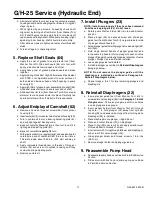
9
G5-991-400B
G/H-25 Maintenance
NOTE: The numbers in parentheses are the Reference
Numbers on the exploded view illustrations found in this
manual and in the Parts Manual.
Daily
Check.the.oil.level.and.the.condition.of.the.oil..The.oil.level.
should.be.1/4.in..(6.mm).above.the.cast.surface.in.the.upper.
oil.reservoir.
Use. the. appropriate. Hydra-Oil. for. the. application. (contact.
Wanner.Engineering.if.in.doubt).
CAUTION: If you are losing oil but don’t see any external
leakage, or if the oil becomes discolored and contaminated,
one of the diaphragms (22) may be damaged. Refer to the
Fluid-End Service Section. Do not operate the pump with
a damaged diaphragm.
CAUTION: Do not leave contaminated oil in the pump
housing or leave the housing empty. Remove contaminated
oil as soon as discovered, and replace it with clean oil.
Periodically
Change.the.oil.after.the.first.100.hours.of.operation,.and.then.
according. to. the. guidelines. below.. When. changing,. remove.
the.drain.plug.cap.(34).at.the.bottom.of.the.pump.so.all.oil.and.
accumulated.sediment.will.drain.out..
Hours Between Oil Changes @ Various
Process Fluid Temperatures
<90°F
<139°F
<180°F
Pressure
RPM
(32°C)
(60°C)
(82°C)
Metallic Pump Head
<650.psi.(45.bar).
<800.
6,000.
4,500.
3,000.
.
<100.
4,000.
3,000.
,000
<1000.psi.(70.bar).
<800.
4,000.
3,000.
,000.
.
<100.
,000.
1,500.
1,000
Non-Metallic Pump Head
<50.psi.(17.bar).
<800.
4,000.
3,000.
—.
.
<100.
,000.
1,500.
—
NOTE: Minimum oil viscosity for proper hydraulic end
lubrication is 16-20 cST (80-100 SSU).
NOTE: Use of an oil cooler is recommended when process
fluid and/or hydraulic end oil exceeds 180°F (82°C)
for Metallic Pump Head models or when hydraulic end
oil exceeds 180°F (82°C) for Non-Metallic Pump Head
models.
CAUTION: Do not turn the drive shaft while the oil reservoir
is empty.
Check.the.inlet.pressure.or.vacuum.periodically.with.a.gauge...
If.vacuum.at.the.pump.inlet.exceeds.7.in..Hg.(180.mm.Hg),.
check.the.inlet.piping.system.for.blockages..If.the.pump.inlet.
is.located.above.the.supply.tank,.check.the.fluid.supply.level.
and.replenish.if.too.low.
CAUTION: Protect the pump from freezing. Refer also to
the “Shutdown Procedure”.
Shutdown Procedure During
Freezing Temperatures
Take all safety precautions to assure safe handling of the
fluid being pumped. Provide adequate catch basins for
fluid drainage and use appropriate plumbing from drain
ports, etc. when flushing the pump and system with a
compatible antifreeze.
1.. Adjust.the.discharge.pressure.regulating.valve.so.the.pump.
runs.under.minimum.pressure..Stop.the.pump.
.. Drain.supply.tank;.open.any.draincocks.in.system.piping.and.
collect.drainage;.remove.plug.(4).from.manifold.and.collect.
drainage.
3.. Close. draincocks. in. system. piping. and. replace. manifold.
plug.
4.. Fill.supply.tank.with.enough.antifreeze.to.fill.system.piping.
and.pump.
.
NOTE: Disconnect the system return line from the supply
tank and connect it to a separate reservoir.
5.. Start.the.pump.and.allow.it.to.run.until.the.system.is.filled.
with.antifreeze..
NOTE: If the system has an airlock and
the pump fails to prime, follow step 4 of the Initial Start-
Up Procedure to clear the air.
6.. When.mostly.antifreeze.is.flowing.from.the.system.return.line.
stop.the.pump..Connect.the.system.return.line.back.to.the.
supply.tank.and.circulate.the.antifreeze.for.a.short.period.
7.. It.is.also.good.practice.to.change.the.oil.in.the.hydraulic.
end.before.storage.for.an.extended.period..This.will.remove.
any. accumulated. condensation. and. sediment. from. the.
oil. reservoir.. Drain. and. refill. the. hydraulic. end. with. the.
appropriate. Hydra-Oil. and. operate. the. pump. for. a. short.
period.to.assure.smooth.performance..




















